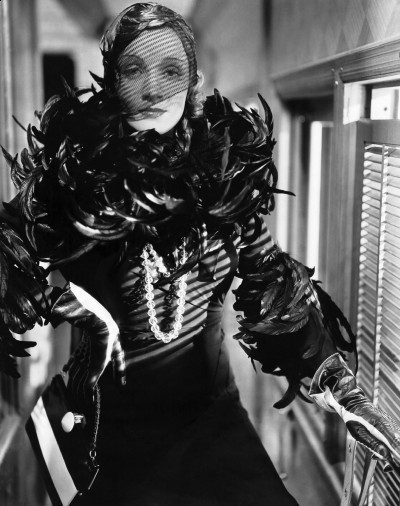
What do Night of the Hunter (1955), Carrie (1976), City Lights (1931), The Hours (2002), Shanghai Express (1932), and The Old Dark House (1932) have in common? Well, nothing really—except that at recent Asheville Film Society and Thursday Horror Picture Show screenings, I spent all but one of those titles standing up. Why? Because there weren’t any seats or even supplementary chairs left and I’m too old to sit on the floor. The only one where I got a seat—The Old Dark House—was a very near thing. I’m not complaining, mind you, but I am on the perplexed side.
For those of you who don’t know, my co-critic Justin Souther and I host and program these showings, so we have a vested interest in trying to come up with titles that both draw viewers and offer diversity and some degree of educational component about film and film history. Well, we can do the last two fairly easily, but I’m more and more convinced that choosing titles that will draw viewers is almost entirely a crapshoot. I suppose that should make me despair, but it honestly fascinates me and makes for happy surprises. I like that—and I like audiences that are willing to take a chance.
Of course, I realize that this all has something to do with the weather. There were nights during the dead of winter when I wouldn’t have been at screenings if I didn’t have to—not to mention a couple of occasions when I couldn’t get there. I can hardly blame anyone for missing some of the offerings during that time. But I don’t think the big thaw is the whole explanation—certainly, it doesn’t explain some of the reactions.
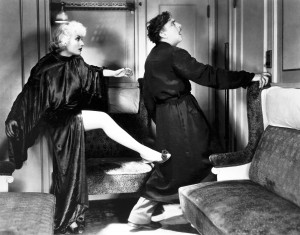
When this first started, I was hesitant to run too much that was terribly old. I was gun-shy to a great degree on this because of responses I’d had to the idea of Asheville supporting a repertory house cinema. There seemed little enthusiasm for anything pre-1950. We got more experimental in this regard with the horror film series first, slipping in James Whale’s Frankenstein (1931) early on—and we ended up with a full house. Then again, that’s kind of a pre-sold title even after 80 years. I think the first vintage title we pulled out for the AFS was Howard Hawks’ Twentieth Century (1934) and the attendance was good without being great. But the response was only so-so, and some people actually said they’d hated it. I still don’t understand it. I’d like to run it some day for a different audience, because this was the only time I’ve ever seen that film fail with an audience.
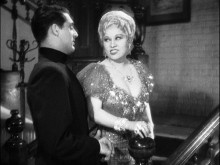
At the same time, a double feature of Mae West films—Night After Night (1932) and She Done Him Wrong (1933)—found me standing up through the screening. Miss West was a hit in turnout and in response, but the real surprise for me was that a great deal of the audience had never actually seen one of her movies. Her name, however, was known and intriguing enough to bring ‘em in. She’ll be making an encore appearance at some point. It will be interesting to see if she draws a crowd a second time. She certainly ought to. And logic tells me she should do just that, but I’m not convinced logic has very much to do with it.
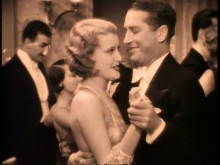
Films like John M. Stahl’s Imitation of Life (1934), Mervyn LeRoy and Busby Berkeley’s Golddiggers of 1933 (1933), Rouben Mamoulian’s Love Me Tonight (1932), and Ernst Lubitsch’s One Hour with You (1932) did well enough, though the last name was just before Thanksgiving and suffered a dip as all movies do when people are gearing up for a holiday. For me, it was worth it, though because the audience we did have loved it—and one woman told me, “I’ve never seen a movie that old before, and it was just so charming.” That pretty well made my night—except that I wished she’d seen Love Me Tonight, which is even more charming and has better songs. We also had a strong turnout for our first silent film—F.W. Murnau’s Sunrise (1927)—and again I was surprised by the number of people who’d never seen any silent movie. And I was even more surprised by the way they took to it and a style of acting that was utterly foreign to them.
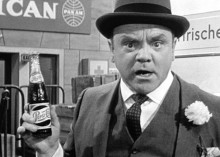
Some things remain perplexing. Why did a topical comedy (topical in 1961) like Billy Wilder’s One, Two, Three draw a large crowd? Why did it play well? Why did the audience applaud it warmly? And why did one young couple—who’d been to almost every movie that had been shown—get up about 20 minutes into it and leave? More, why have they never been back? Did something that completely eludes me offend them? I shouldn’t be bothered by this, I suppose, but I am. I’d love to know. I’d love to know what happened to the little group of teenage boys who showed up for every old horror movie we ran—and then just stopped.
To go back to the films I first mentioned—with Casino Royale (1967) and The Brides of Dracula (1960) boasting nearly full houses—I wasn’t entirely taken by surprise. I had expected a big turnout for The Hours and a good one for Night of the Hunter. City Lights I was less sure of, but the Chaplin name and reputation made it seem a reasonably good bet in terms of attendance. I was less sure about the response. I was pretty sure the comedy would hold up, but less certain of the sentiment, but both played well. The real shocker was Shanghai Express.
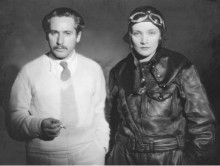
As recently as 35 years ago—before home video all but killed off rep houses and college screenings—Shanghai Express was a staple. Actually, just about any Josef von Sternberg film was guaranteed a solid response—in part due to Andrew Sarris’ inclusion of Sternberg as one of his “pantheon” directors in his 1968 book The American Cinema. Being a part of those Sarrisfied years—augmented by reading and re-reading John Baxter’s The Cinema of Josef von Sternberg (1971) in college, and Baxter’s earlier assessment of the filmmaker (“No theory of the cinema is viable unless it considers Josef von Sternberg one of its major talents.”) in Hollywood in the Thirties (1970)—Sternberg is ingrained in me as absolutely essential. There was never any question about him being represented in our screenings. But I figured he was long out of pop culture consciousness and hadn’t much hope for a big response.
I was more than a little surprised as the place filled up and the overflowed, but I wasn’t entirely wrong about Sternberg. Introducing the film, I asked who had come because of Josef von Sternberg. Two hands went up. Uh huh. “Who’s here because of Marlene Dietrich?” The other 80-odd hands went up. Never underestimate star power—even if the star only became a star thanks to the filmmaker (with a little help from the Paramount publicity department). So the draw was Dietrich, and that was OK. The question was how would it play to an audience now?

Shanghai Express isn’t just an “old movie,” it’s a very specialized kind of movie. It’s part of a filmmaker’s personal mythology—and that of his star. Everything about it is stylized, right down to the acting and the approach to the dialogue delivery—and, of course, it’s all painstakingly lit to make its star as glamorous as possible. The story is romantic pulp fiction that once casts a cynical gaze on the material and transcends it. It could have been laughable if the movie hadn’t recognized its own absurdity. Would the audience understand that? How would they respond to Sternberg’s non-stop visual assaults and his “outdated” use of long dissolves and practice of layering image on top of image (and sometimes on top of another image)?
One of the drawbacks of watching from the bar area of the Lounge is that you can’t hear very well. It wasn’t like I needed to hear the dialogue—the movie is so ingrained that I can say every line of dialogue in advance of the actors—but I wanted to hear the audience. From what I could hear they were laughing at all the right points and not laughing at the wrong ones. Then as the final scene played out—and the audience got the gag of having Dietrich take the price tag off Clive Brook—I knew the film had bridged the years. I still was surprised when the Paramount mountain came into view and they broke into the largest round of applause I’ve ever encountered at one of these screenings.
I’m not going to seriously attempt to analyze why. It’s not just Dietrich lovingly photographed in an improbable array of stunning Travis Banton gowns by a filmmaker who was completely obsessed with her. That’s certainly part of it, but hardly all. I doubt seriously if any of the audience will have to be told again who Josef von Sternberg is. (We’ll test that theory eventually.)
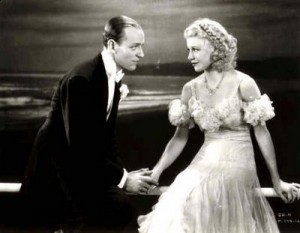
What I would like to believe is happening overall is that our audience is becoming more and more open to the idea of trying the unfamiliar—of expanding their appreciation of movies without regard to the parameters of age. Massive turnouts in the space of a couple weeks for Shanghai Express and The Hours—movies separated by 70 years—tends to make me thing that way. So what will happen when we follow this week’s showing of Pedro Almodovar’s Talk to Her (2002) with Mark Sandrich’s Fred Astaire-Ginger Rogers film The Gay Divorcee (1934)? Almodovar is a proven draw—both Women on the Verge of a Nervous Breakdown (1988) and All About My Mother (1999) were big draws. Astaire and Rogers have yet to be tried. I’m certainly interested to find out. The audience may surprise me in some new way. That keeps things interesting.




It should be interesting to see if this trend continues with “Talk to Her”. Have you shown foreign movies before? Though this is my favorite Almadovar film, I suspect that audiences would warm up to something like “Woman on the Verge of a Nervous Breakdown” before this one.
This is our third Almodovar. Nervous Breakdown was out first and was wildly successful. All About My Mother nearly matched it. So we’ll see about this. I’m actually more curious about the horror film screening of Santa Sangre — not so much how many show up, but how many walk out. Justin and I have a maxim that it’s not really a Ken Russell picture until somebody walks out. I suspect it’s not really a Jodorowsky movie till at least four people walk out.
I might need to get a drink or two at the bar just to get me through “Santa Sangre”. I’m pretty open when it comes to what I’m willing to watch, but Jodorowsky, if “El Topo” is any indication, is not for me. At any rate, this should be a nice way to finally see “Santa Sangre”.
I’m pretty open when it comes to what I’m willing to watch, but Jodorowsky, if “El Topo” is any indication, is not for me
Santa Sangre is more accessible (on a relative scale), but in some ways I think it’s more disturbing. Then again I’ve just seen it, so it’s fresher in my mind. Thursday will mark the third time I’ve seen it. It will be some considerable time before I’ll be in the market to see it again.
Want to do a roundtable afterwards? I hope to be there.
Want to do a roundtable afterwards? I hope to be there.
We’ll see who’s left standing. If you’re coming, bring the Bluray and we’ll run it instead of the regular DVD.
You got it. I don’t personally own too many blu-rays, but this is one for the collection.
Well, I guess TECHNICALLY I own about 1000 blu-rays and 40,000 dvds.
Well, I guess TECHNICALLY I own about 1000 blu-rays and 40,000 dvds.
And of those, how many would you not watch on a dare?
And of those, how many would you not watch on a dare?
Dare to watch or not to watch? I think my ratio of good films/sucky films is pretty good.
Dare to watch or not to watch? I think my ratio of good films/sucky films is pretty good.
I feel the question has been dodged.
I feel the question has been dodged.
Who dodged?
Who dodged?
Let me rephrase it (I’ll hate myself later) — you have 40,000 DVDs, right? Okay, now, of those how many of them would you not watch even if somebody said, “Go on, watch The Country Bears (or some other lox), I dare you.”
On a totally different topic, Almodovar is now three-for-three as a big draw and a crowd pleaser.
Let me rephrase it (I’ll hate myself later)—you have 40,000 DVDs, right? Okay, now, of those how many of them would you not watch even if somebody said, “Go on, watch The Country Bears (or some other lox), I dare you.”
I knew what you were talking about. Keep in mind that I’ve had at least one kid since 1994, so I have seen some real stinkers (like The Country Bears). I do like watching the worst of the worst though. The ones that I tend to avoid are dramas like CONVICTION and HEREAFTER.
On a totally different topic, Almodovar is now three-for-three as a big draw and a crowd pleaser
Play MATADOR next. See how many people walk on that one.
Keep in mind that I’ve had at least one kid since 1994, so I have seen some real stinkers (like The Country Bears).
You see, my daughter was watching Tommy, Lisztomania and Rocky Horror by the age of four, so I side-stepped a lot of this.
The ones that I tend to avoid are dramas like CONVICTION and HEREAFTER.
That I can understand.
Play MATADOR next. See how many people walk on that one.
I bet it’d be okay, honestly. There’s not much Almodovar can’t make sympathetic. I think Bad Education — which, as I told the audience the other night, is the reason I can’t go to Hendersonville anymore — would be a better test.